Üniversite Siteleri
+90 (346) 487 5160
erasmus [at] cumhuriyet.edu.tr

International Staff Week is an event that brings together staff members from different universities, colleges, and institutions from around the world to share knowledge, experiences, and best practices. It is one of the most important internationalization activities of Sivas Cumhuriyet University.
The International Staff Week provides an excellent opportunity for participants to network with colleagues from different parts of the world, learn about new cultures, and gain a fresh perspective on their work, have the experience of teaching in a foreign context. During the event, there are workshops, seminars, and presentations that focus on different topics related to higher education, such as internationalization, intercultural communication and student mobility.
The International Staff Week is also a great opportunity for participants to explore the host city and its surroundings. The host institution usually organizes cultural and social events, such as city tours, museum visits, and dinners, to give participants a taste of the local culture and cuisine.
Professional Development: Attending an International Staff Week provides staff members with the opportunity to learn about new approaches and best practices in higher education. Participants can attend workshops and seminars, and exchange ideas with colleagues from different institutions, gaining insights that can help them enhance their teaching and administrative skills.
Networking: The event brings together staff members from different parts of the world, providing a valuable opportunity to expand professional networks. Participants can establish contacts with colleagues who share similar interests, and potentially develop partnerships for future collaborative projects.
Cultural Exchange: An International Staff Week is a unique opportunity to experience the local culture and customs of the host country. Participants can gain insights into the daily life, traditions, and cuisine of the host city, and develop a greater appreciation for cultural diversity.
Personal Growth: Participating in an International Staff Week can be a transformative experience, helping participants develop new perspectives and ways of thinking. Exposure to different teaching methods, cultural practices, and languages can broaden horizons and expand intellectual and personal growth.
Institutional Development: An International Staff Week can also benefit the institution where the staff member is employed. Participants can bring back new ideas, insights, and best practices, which can be shared with colleagues and incorporated into the institution’s teaching and administrative practices. This can contribute to the institution’s overall growth and development.
The mission of the International Staff Week organized by Sivas Cumhuriyet University is to foster a collaborative and supportive environment for international university staff to exchange best practices, share knowledge and experiences, and develop new ideas and strategies for enhancing the quality of higher education. Through this program, we aim to provide a platform for professional development, networking, and intercultural exchange, while also promoting the values of diversity, inclusion, and innovation.
Our vision for the International Staff Week is to become a leading platform for international collaboration among university staff from around the world. We aspire to create a vibrant community of professionals who are committed to advancing the field of higher education through sharing their expertise, insights, and ideas. We aim to cultivate a culture of continuous learning, growth, and innovation, where participants can explore new approaches to teaching, research, and administration, and develop new partnerships and collaborations that will benefit their institutions and communities. Our ultimate goal is to promote excellence in higher education and contribute to the development of a more connected and inclusive global society.
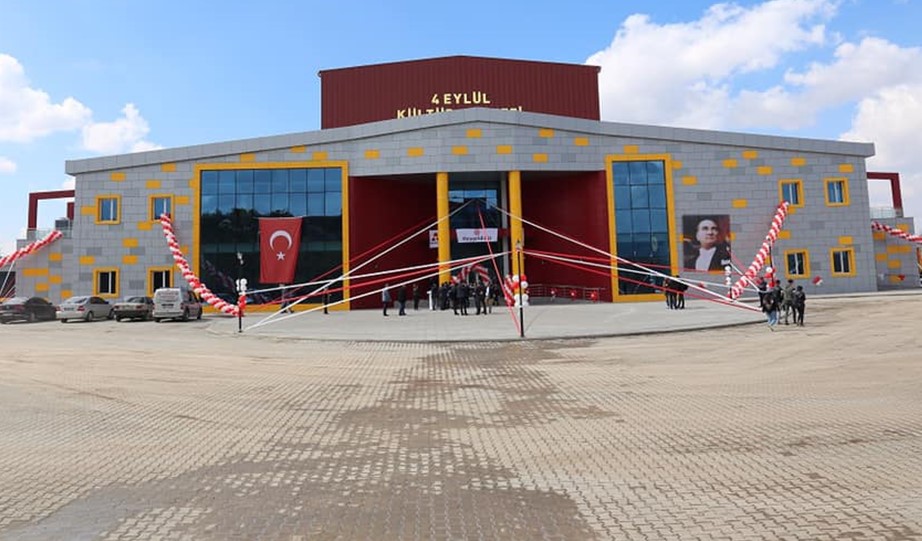
University History Museum
Opened on February 9, 2022, on the 48th anniversary of the foundation of our university, It is the second university history museum in Turkey. The museum displays various documents, items, publications, photographs, and artwork that tell the history of the university from its founding in 1974 to the present day. The majority of the items on display were obtained from the university’s archives and various departments, as well as donations from individuals who have contributed to the university. The art collection was also entirely acquired through donations, and efforts are ongoing to continue developing and updating both collections.
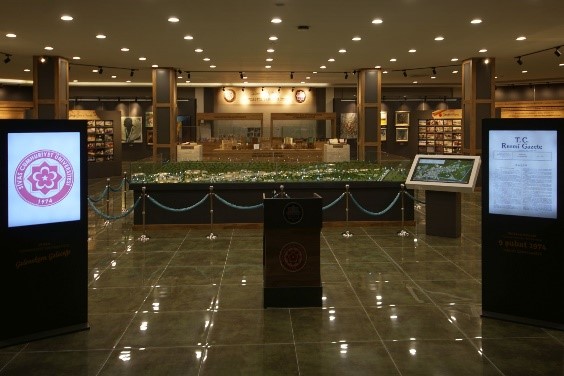
Natural History Museum
Located within the university’s 4 Eylül Culture Center, Natural History Museum houses a vast collection of geological and biological specimens from Sivas and beyond. With over 3,000 exhibits, including minerals, rocks, fossils, and plant and animal specimens, our museum provides a window into the Earth’s past and present.
Explore the diversity of our planet’s geology and learn about natural phenomena such as earthquakes and volcanoes. Our interactive displays, including a smoking volcano model, augmented reality sandbox, and microscopic examinations, bring science to life for visitors of all ages.
At the Natural History Museum, we’re dedicated to promoting environmental awareness and conservation. We believe that by sharing knowledge about our natural world, we can inspire a love of nature and encourage people to protect it for future generations. Many of our exhibits were generously donated by individuals and organizations, and we proudly recognize their contributions in our displays.
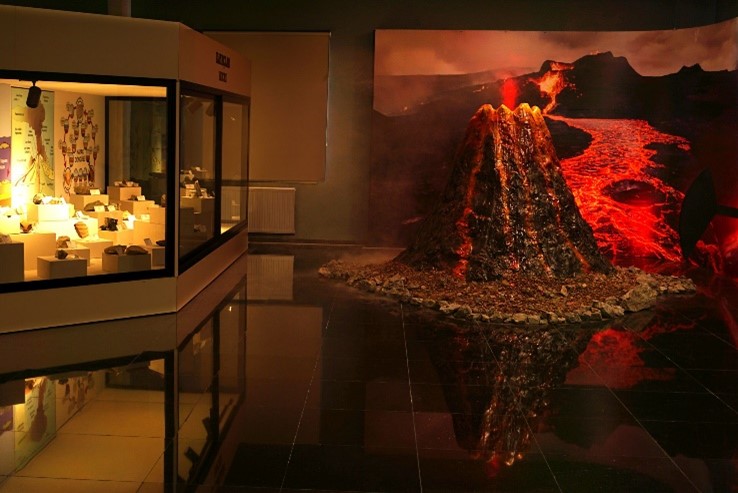
Named after the Kangal district in Sivas Kangal dog is a valuable and unique local breed in Turkey known for its massive size, domestic nature towards the owner and its amazing ability to protect flocks from external threats, particularly against wolves. The breed’s history can be traced back to ancient Anatolian civilizations, and it is considered to be a cultural heritage of our country, particularly in the Sivas region. The Kangal Dog Research Center aims to promote the breeding of Kangal dogs under optimal conditions and has been recently renovated to provide suitable living conditions for the breed.
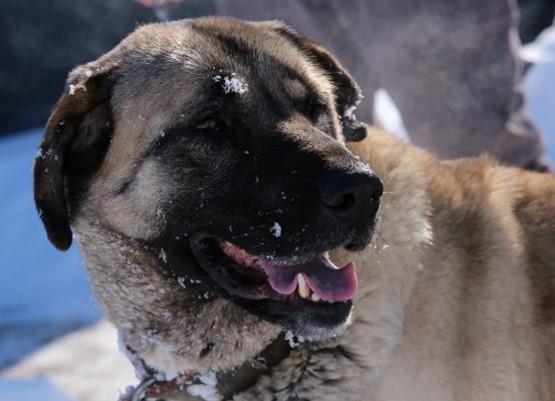
Looking for a peaceful and scenic getaway? Hasbahçe Lake in Sivas Cumhuriyet University campus is the perfect destination for you. This serene artificial lake is a great place to relax, unwind, and enjoy the beauty of nature. You can take a leisurely walk or hike around the lake and enjoy the breathtaking views, or have a picnic on the grassy shores. There are also many places to sit and enjoy the tranquility of the area, making it the perfect place for a short break from the busy schedule of daily life n addition, don’t miss the chance to visit MiniaSivas, the miniature replicas of important historical buildings in Sivas within Sivas Castle, to see the historic Sivas within a few steps
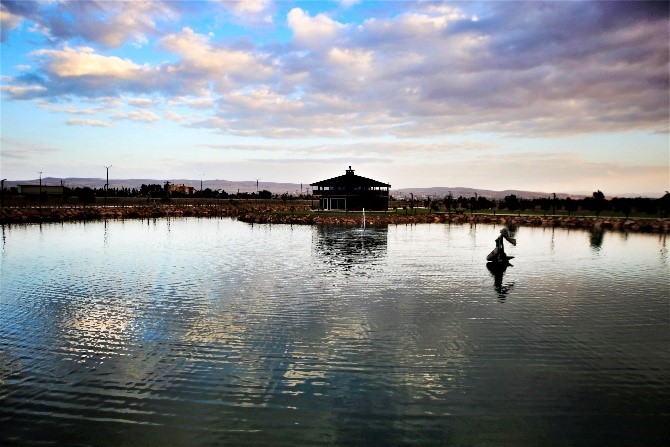
We are thrilled to offer you the opportunity to indulge in the rich flavors and culinary traditions of Sivas and Turkey during our International Staff Week. Our lunch, which will be held in one of the most renowned restaurants in the city, will give you a chance to bond with your fellow participants from all over the world over a delicious meal and learn about the local culture through its food. The menu is carefully curated to showcase the best of Turkish cuisine, with a variety of traditional dishes that will tantalize your taste buds. From succulent meats to fresh vegetables and flavorful spices, we guarantee that you will leave feeling satisfied and inspired. Best of all, the lunch is completely free of charge for all of our participants!

Hamidiye Park is a historic landmark that dates back to the reign of Abdülhamit Han. Originally built in 1889 as a horse stable for the palace, this area has since been transformed into a hub of entertainment and culture thanks to extensive restoration efforts led by Sivas Governorate and Sivas Provincial Administration Explore the history of horses in Turkish and global cultures and witness their importance in war and peace in War Horses Museum.
The historical stone building, located in the eastern part of Hara overlooking the Ankara road, is the largest structure of the campus with a closed area of 1,800 m2. The barn, which once housed 150 horses, has a rectangular shape extending in the east-west direction. The building is entered through two separate side doors opening to the east and west and the main door opening to the south. The historical building, which has been restored in accordance with its original form, takes people into the depths of the past with a modern museum approach, from the domestication of the horse to its companionship with humans, from the mount to carrying loads, and above all, to its agility on the battlefields, with its visuality, horse sculptures, information and document tables.


The Sivas Historic City Square is a must-see destination for history enthusiasts and architecture lovers alike. The square is home to a unique blend of buildings from different eras of history, including the Seljuk Empire, Ottoman Empire, and Turkish Republic. Visitors can marvel at the intricate details and striking designs of these structures, each of which tells its own unique story.
Buruciye Madrasa, is a must-see destination for any traveler interested in Islamic architecture and history. Built in 1271 during the reign of Seljuk Sultan III. Giyaseddin Keyhüsrev, this madrasa was designed to teach physics, chemistry, and astronomy to students. The building, which is known for its symmetrical and well-preserved design, features a magnificent crown gate, intricate tile work, and an open courtyard made of cut stone. With four-iwan and two-stories, Buruciye Medresesi is a true architectural masterpiece that showcases the skill and artistry of the Seljuk builders. Visitors will be amazed by the harmonious elements of the building, including the ornate windows on the sides of the crown gate and the corner towers with battlements.

Şifaiye Madrasa is one of the most important madrasas from the Seljuk era, where patients were treated and medical education was also carried out. The remaining part of the madrasa that still exists today is the largest infirmary in Anatolia. It was built in 1217/18 by King Izzeddin Keykavus. Visitors enter through a grandiose decorated entrance door to a courtyard with four porticos and arcades. On the entrance door, there are symbols of the sun and moon, and in the main portico, there are reliefs in the shape of a man and woman’s heads. In 1220, King Izzeddin Keykavus was buried here, and the southern portico was turned into a tomb.

Double Minaret Madrasa (Çifte Minareli Medrese), which was built by the Ilkhanid Vizier Sahip Şemseddin Mehmet Cüveyni in 1271/1272. The original remaining feature of the building is its grand and imposing front façade with the highest portal in Anatolia. The two minarets rising above the portal have become a symbol of Sivas. It is one of the most beautiful madrasas ever built in Anatolia. The building has two floors and four porticos. The brick minarets on the portal are decorated with glazed tilework. The stone portal decorated with vegetal and geometric motifs, and give the building a dynamic appearance. It is still in good condition and open to visitors.
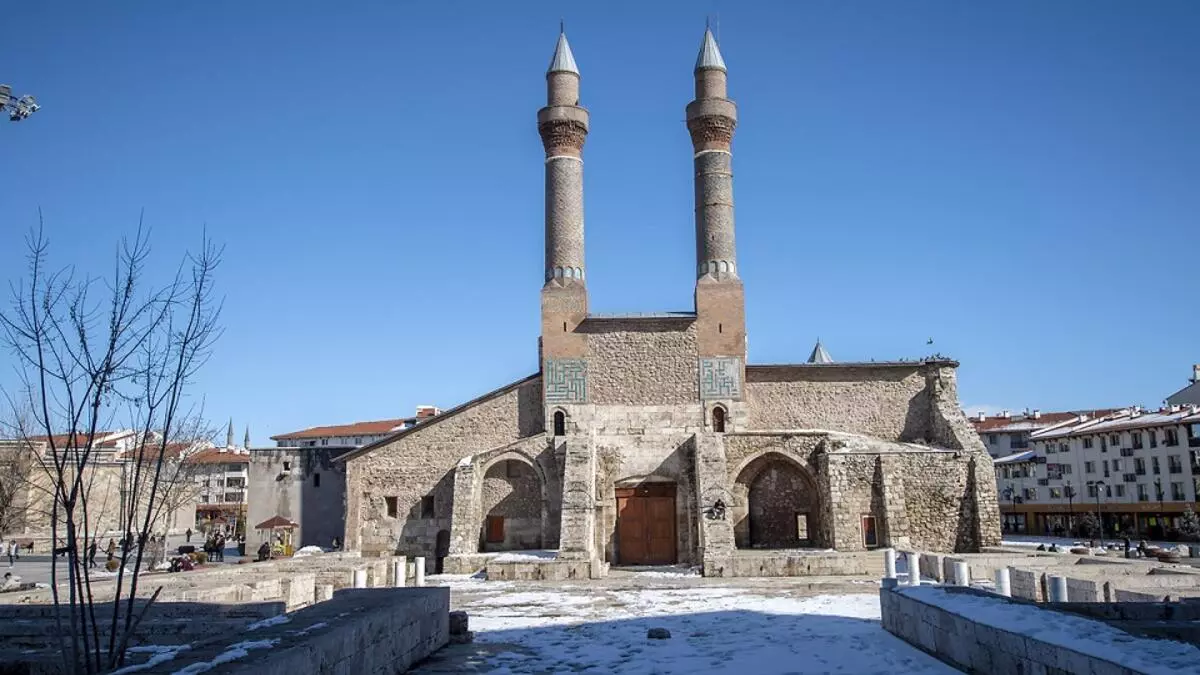
Kale Mosque, built in 1580 during the reign of Sultan Murad III by Ali Beyoğlu Mahmud Paşa, the Governor of Sivas, takes its name (kale- fortress) from its unique square fortress-like design, constructed of cut stone for the walls and brick for the minaret. It is one of the most important examples of Ottoman era mosque architecture.
The mosque also features two striking stone structures on either side of the mosque. One of these is a partially hollowed stone located in the courtyard in front of the mosque, known as the “Sadaka Stone.” It was traditionally used by Muslims who attended the evening prayer, to leave their donations in the hollowed section of the stone. Similarly, people in need who wanted to keep their poverty private would only take what they needed from the stone during the darkness of night, being careful not to take more than their fair share.
The second stone, located beneath the minaret, is known as the “Stone of the Lost.”. It is believed to have been used in the past as a place for people to leave valuable items, such as jewelry or money, that they had found. The mosque’s caretakers would keep the items safe and return them to their rightful owners when they came looking for them as the first place.
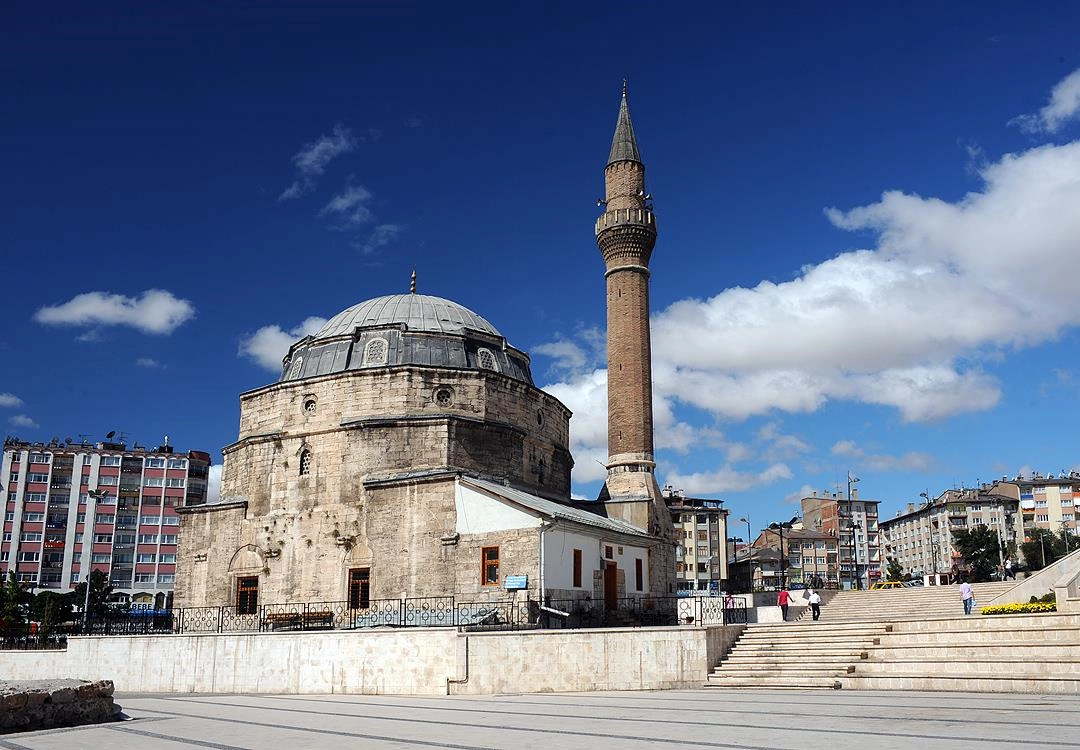


Sivas Ulu Cami is not just any ordinary mosque, it is a treasure trove of history and culture, steeped in rich tradition and heritage. As one of the oldest mosques in Anatolia, it stands as a testament to the architectural brilliance of the Danismend period. Built in 1196-1197 by Kul Ahi during the reign of II. Kılıç Arslan’s son, Kutbettin Melik Shah, the mosque is a beautiful example of the collective space concept in mosque architecture.
The cylindrical minaret with a octagonal base is located in the southeast corner, it’s body is made of brick and decorated with tiles. The minaret, which leans to one side, resembles the Leaning Tower of Pisa and is a must-see attraction
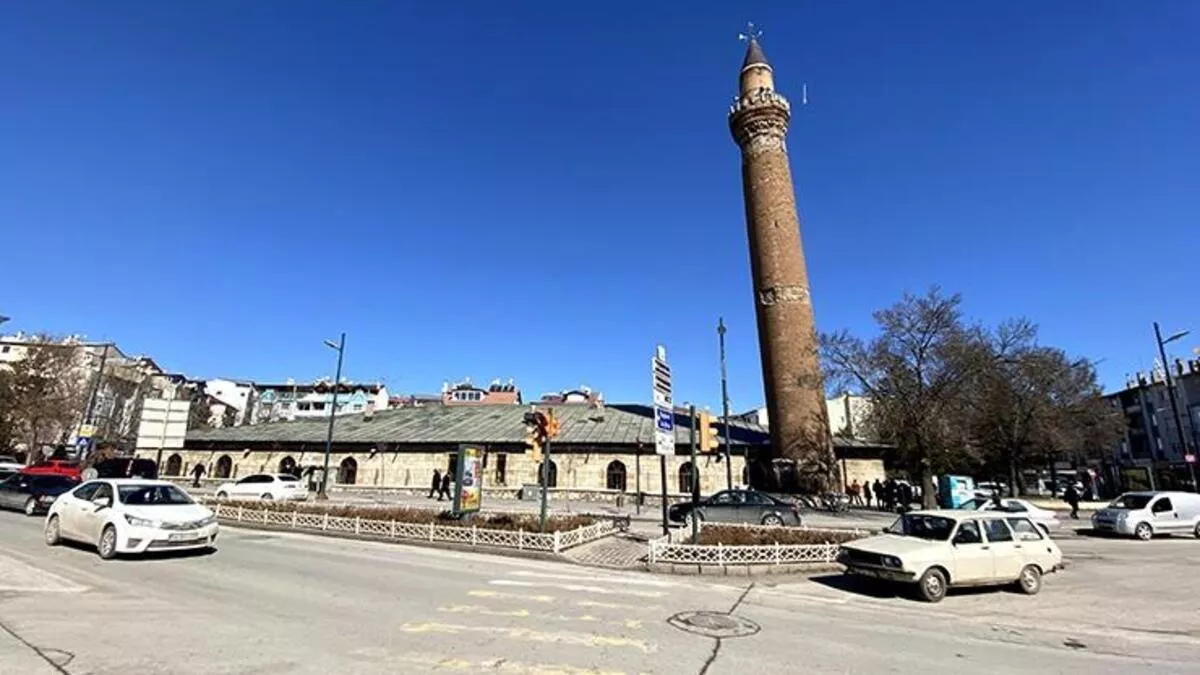
Take advantage of your free time during the International Staff Week programme and explore the beauty of the surrounding area. With 1 and a half hours of free time, you will have the opportunity to visit the places of interest in the area.. This is the perfect chance to relax, rejuvenate and take in the sights and sounds of the local culture
Join us during International Staff Week as Lecturer Emre SEVEN, a commited interculturalist, takes you on a journey to understand how our brains and minds process communication between different cultures. This seminar will provide you with valuable insights and strategies for effectively communicating with individuals from different backgrounds. Don’t miss out on this opportunity to improve your intercultural communication skills and gain a competitive edge in today’s globalized world.
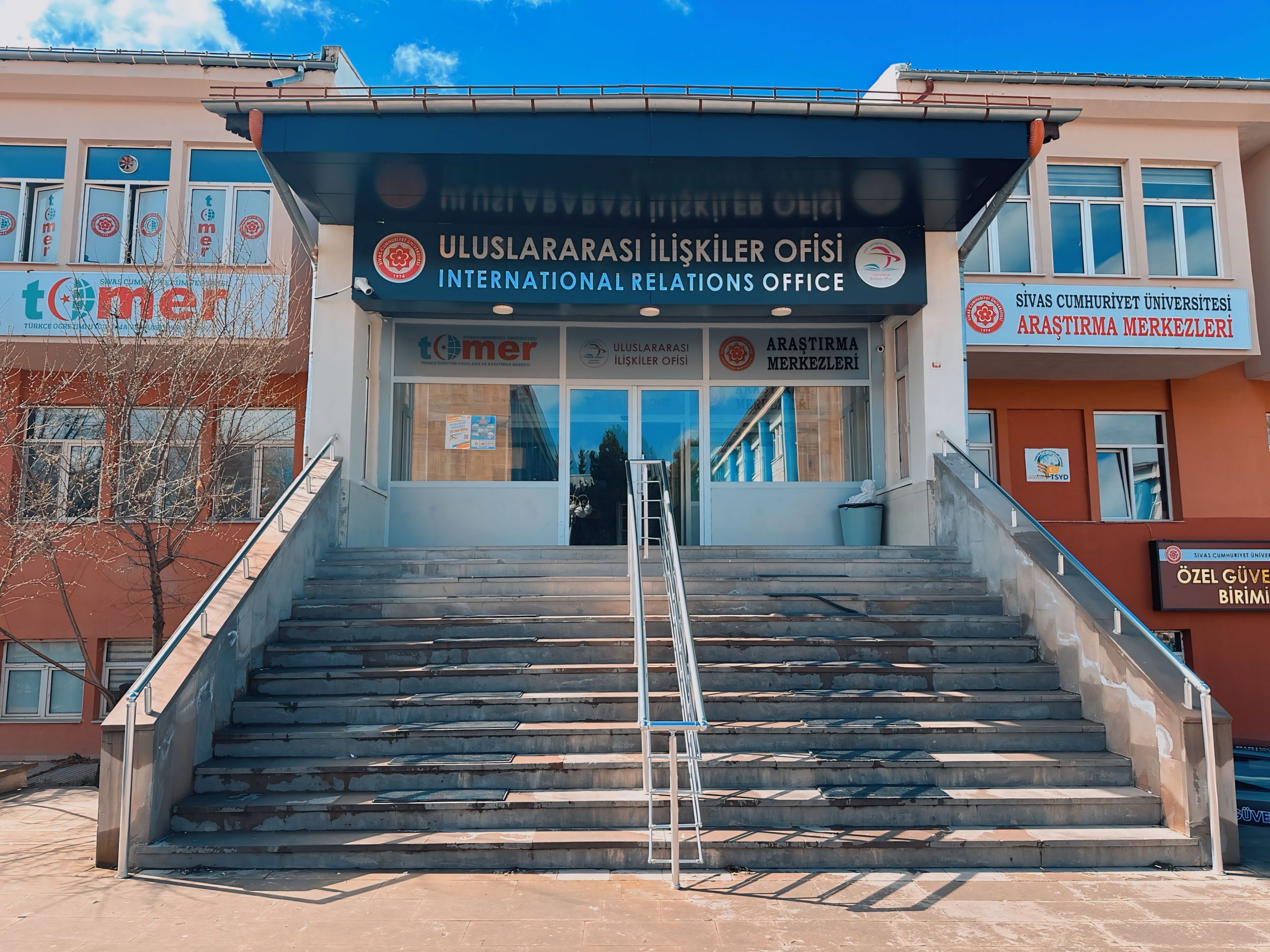
The participants are going to be paid their Erasmus grants at the Vakıfbank unit located in the campus.
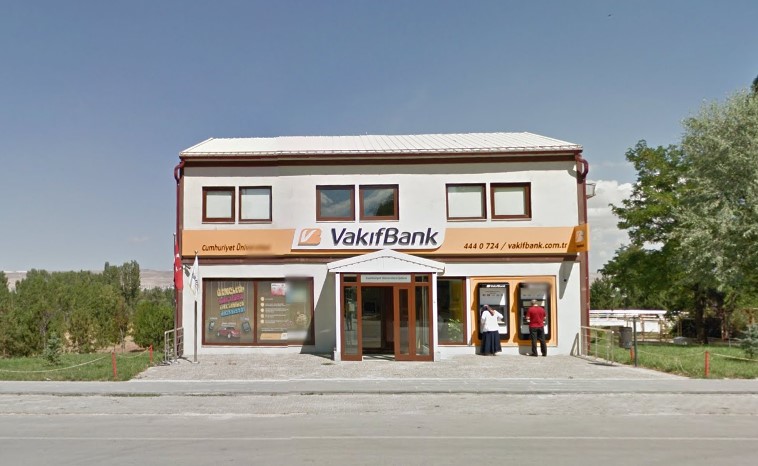
Participants are free to to carry out their academic work at the departments.

Come and join us for an unforgettable day-trip excursion during International Staff Week to the stunning Gürün Gökpınar Lake. Nestled just 10 kilometers away from the city center, this natural gem boasts crystal clear and sweet water that is sure to take your breath away. With depths reaching up to 17-20 meters, the lake’s water is so clear that even small objects dropped in can be clearly seen all the way to the bottom. The lake also changes color depending on the angle of the sun, earning it its name “Gökpınar” which means “sky-blue.” The lake is split into two parts, the smaller “Küçük Göl” is used for trout production, while the larger “Büyük Göl” is a popular tourist destination for rafting and other activities. With an area of 3,000 square meters, Gürün Gökpınar Lake is like a natural aquarium, and its water is very sweet and cold. And the best part… A free lunch for all participants featuring fresh-caught trout from the lake. Don’t miss this opportunity to explore the natural beauty of Gürün Gökpınar Lake with us!
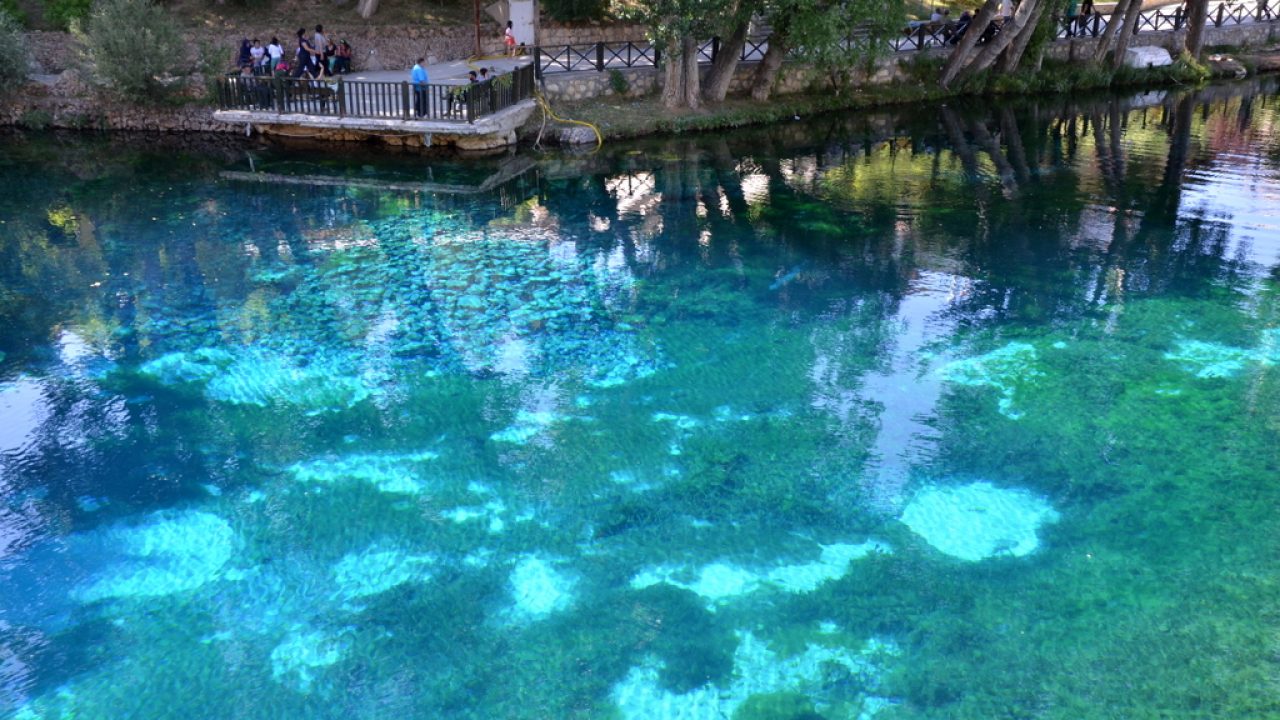
Join us for the unforgettable closing ceremony at the International Relations Office, where we will gather to reflect on the enriching experiences of the past 5 days. Indulge in delightful Turkish Tea & Coffee as we come together. Participants will have the opportunity to share their insights, evaluations, and overall reflections on the program. The event will culminate with a certification ceremony, followed by a memorable photo session.

University Museums
Kangal Dog Research Center
Hasbahçe Lake
Hamidiye Park
Buruciye Madrasa
Double Minaret Madrasa
Şifaiye Madrasa
Kale Mosque
Ulu Mosque
Gökmedrese Museum
Opening Ceremony – 4 Eylül Culture Center
Culture Night – Susamışlar Mansion
Workshop and Seminars – International Relations Office
Teaching & Training Activities – At the Departments
Meeting Lunch – Çamlık Restaurant
Excursion Lunch – Gürün Gökpınar Restaurant
International Relations Office
Participants who cannot make it to Sivas on Sunday, May 11, 2024, can use the airport bus service to get to the city centre. The airport bus service is ready and available for every flight. There are two buses available: HAVAŞ (white colour) and Municipality bus (red colour).
![havaalanina-otobus-seferi-vatandasi-memnun-et-3488353_o[1]](https://erasmus.cumhuriyet.edu.tr/wp-content/uploads/havaalanina-otobus-seferi-vatandasi-memnun-et-3488353_o1.jpg)
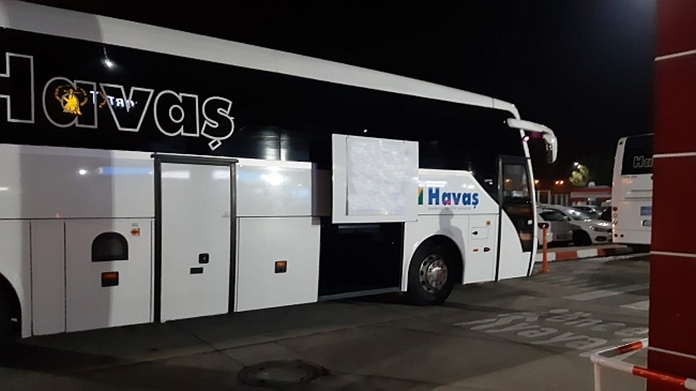
For Sunday arrivals, we arrange a shuttle service (free of charge).
ALBANIA
CUBA
ETHIOPIA
GEORGIA
GHANA
KYRGYZSTAN
KOSOVO*
MOLDOVA
MONTENEGRO
MOROCCO
SOMALIA
Abdelmalek Assaidi University
Bahir Dar University
Comrat State University
Georgian Technical University
Kumasi Technical University
Mogadishu University
Osh State University
Pokhara University
University of Adriatic Bar
University of Havana
University of Mitrovica
University of Tirana
ACADEMIC UNITS
ARCHAEOLOGY
BIOLOGY
BUSINESS MANAGEMENT
CHEMICAL ENGINEERING
CHEMISTRY
CIVIL ENGINEERING
ECONOMICS
ENGLISH LANGUAGE AND LITERATURE
FINANCE AND BANKING
HEALTH MANAGEMENT
LAW
NEW MEDIA AND COMMUNICATION
NURSING
PHYSICS
SOCIOLOGY
SOFTWARE ENGINEERING
TOURISM MANAGEMENT
TRANSLATION AND INTERPRETING
TURKISH AND SOCIAL SCIENCES EDUCATION
TURKISH LANGUAGE TEACHING
ADMINISTRATIVE UNITS
FINANCIAL AFFAIRS
GENERAL SECRETARY OFFICE
INTERNATIONAL RELATIONS OFFICE
RECTORATE
STAFF AFFAIRS UNIT
.
Meat and cereals are important in Sivas cuisine and dairy products are also frequently used. The fact that the climatic characteristics of the city allow different vegetables, fruits, and legumes to be grown in different regions increases the diversity of the local cuisine.
Winter preparations have an important place in shaping the cuisine culture of the city. It is an essential necessity to make preparations at the end of summer for the forthcoming long and difficult winter in Sivas. Food prepared for the winter include flour, bulgur, cracked wheat, braised meat, pescutan yoğurt, butter, cheese, noodles, kadayif, and pickles.
When the flourishing spring arrives at Sivas, natural flavors that are longed for begin to enter the kitchens. Especially the herb called “madımak” (knotweed) is important in local cuisine. Madımak, which is used in many dishes from soups to chilis, from braised meat to rice pilaf, is so loved in this city that it has been made the subject of folk songs.
When the cuisine of Sivas is referred to, an extremely rich cuisine culture starting from Ottoman cuisine to the present day comes to mind. Sivas köfte (meatballs) registered in the name of the city, Sivas kebab with vegetables, Sivas etli ekmek (meat on bread), pescutan soup, pezik pickles, pickle omelet, bakery katmer and buns, madimak rice pilaf, Divriği pilaf, baked head, hurma (sweet pastries) dessert, hıngel, kazan simidi (cauldron bagel) are just a few of the flavors that linger on the palates from this rich cuisine.
Within the scope of the “Sultan of Cities, Safe Food Land” project, many businesses operating in the food industry and fulfilling the requirements have been awarded the “Safe Food Certificate”.
Peskütan Soup
Peskütan is a kind of yoghurt prepared with fresh milk in spring to be consumed during winter in Sivas. This flavor from Sivas has made a name for itself throughout Türkiye thanks to its long shelf life. It is a regional flavor with high nutritional value, which is prepared by the addition of onion sauce called soharıç after cooking the cracked wheat and green lentil boiled with pescutan, which is then whipped to give it thickness.
Sivas Kebab with Vegetables
Sivas Kebab with vegetables, which is one of the bazaar dishes, is cooked in open-top hearths, which resemble tandoori ovens. The hearth is elevated using bricks. An eggplant, a pepper, a tomato are placed on skewers with an inclined tip in the shape of a cane, and the prepared meats are placed on separate skewers. The skewers are fried vertically on wires on the open-top hearth.
Sivas Köfte (Meatballs)
Sivas Köfte (Meatball), which is a special bazaar food unique to our city, is a brand product of the city, which has been awarded a “Geographical Indication” by Turkish Patent Institute.
Sivas Köfte (meatball) is a special flavor registered in our country in 2011. One of the main features that make Sivas meatballs really special is that the ingredients are only minced meat and salt, and the other special feature is that the kneaded mince is kept in the fridge for a day and then ground again.
Turşu Mıhlaması (Pickle Omelet)
It is a winter dish made with pezik pickles. The branches of the beets, which are removed one by one from the fields and separated from their roots and leaves, are boiled in giant cauldrons and turned into “pezik pickles”. Pezik Pickle Omelet, which is prepared by roasting pezik pickle with onions and then fixing it with eggs into an omelet, is a special dish that comes to the table after soups in Sivas table tradition.
Madımak Herbs
The region is rich in herbs that grow spontaneously in nature. With the spring, various dishes are made from naturally grown herbs, especially the famous madımak. Madımak is distinguished among these herbs. Madımak emerges as the herald of spring after a harsh winter. Although it is known in many parts of Anatolia, madımak is accepted as a taste unique to Sivas.
Divriği Pilaf (Alatlı Pilaf)
This rice pilaf, which is one of the important dishes of Divriği district, carries the memories of the Seljuk Sultans. In Divriği, the capital of Mengücek, this rice pilaf, which the shahs had prepared for holidays and weddings for the people of the whole city and the surrounding villages, is a dish that has been cooked for eight hundred years without any modifications to its recipe. Being cooked slowly over a wood fire as well as the ingredients used, which include lamb, onion, chickpeas, currants or raisins, allspice, butter, and pine nuts, give the rice an unforgettable taste.
Hurma Dessert (Sweet Pastries)
Desserts have an important place in our traditional cuisine culture, not only in terms of taste but also because of their high nutritional value. In Sivas, there are always desserts available on the table according to the season during special days; because a dinner table without dessert is considered incomplete. One of the traditional desserts of Sivas, Hurma Dessert, which is mostly made on holidays and special days, is a dumpling with sherbet.
Pezik Pickle
It is a local pickle made from beet branches in the fall. The beet branches are finely divided and boiled in hot water. The pickles are put in a bowl, subsequently vinegar, garlic, chili peppers, and saltwater are added to prepare the pickles.
Kazan Simidi (Cauldron Bagel)
It is made by Turkish bagel (simit) vendors in the bazaar. The bagels are shaped after the dough, which is prepared with flour, salt, and fresh yeast, is fermented. Subsequently, the bagels are tossed into a cauldron containing boiling molasses water. When the bagel dough rises to the surface of boiling water, it is taken out, sesame is added on top, and it is baked in the oven. A cauldron bagel should be baked in a stone oven using hornbeam wood.
Çörek (Oven Bun)
Sivas çörek (oven bun), which is among the food products that the locals consume the most on a daily basis in Sivas, is a type of pastry that is generally preferred for breakfast but can be consumed at every meal. Melted butter and milk are mixed with yeast, salt, and flour. After giving shape to the bun, egg yolk is applied on top and then it is baked in an oven. Walnut buns are prepared by adding a cup of walnuts to the same dough.
Katmer (Flaky Pastry)
Sivas flaky pastry, prepared from a mixture of water, flour, oil, fresh yeast, egg yolk, and salt, is a traditional flavor registered by the Turkish Patent and Trademark Institute with its distinctive feature in kneading and cooking techniques. It is especially consumed during breakfast and tea times.
Kelle (Sheep’s Head in the Oven)
This meal is one of the important elements of the local food culture of Sivas. It dates back centuries and is also known as “head breaking” because the head of the sheep is broken with an ax. The oven-fried head is consumed in Sivas, especially for breakfast. The head, known as the traditional delicacy of Sivas for about 200 years and cooked in stone ovens for 16-17 hours in airtight cookers in the embers of a wood fire, attracts more attention in the winter months.
You can start the day by tasting “Sheep’s Head in the Oven” in one of the many breakfast restaurants in Sivas. Do not leave the city before trying the “Registered Sivas Meatballs, Sivas Kebab with Vegetables and Sivas Meat Bread” where you will find many alternatives as a local flavor for lunch and dinner.
Prof. Dr. Süleyman DEĞİRMEN – Head of International Relations Office & Erasmus+ Institutional Coordinator
Lect. Emre SEVEN – Erasmus+ Institutional Vice Coordinator
Lect. Murat ERCAN – Erasmus+ Institutional Vice Coordinator
Lect. Emre SEVEN – Staff Week Event Coordinator
Lect. Murat ERCAN – Staff Week Event Coordinator
Ayşe CERAN – Erasmus+ Office Staff
Deniz SÖNMEZ – Erasmus+ Office Staff
Dilber BABA – Erasmus+ Office Staff
Seval MUNZUR – Erasmus+ Office Staff
Uğur YUVACI – Erasmus+ Office Staff
Yasemin KAN – Erasmus+ Office Staff
Radia ABBA – Erasmus+ Office Trainee
Buğkan Ege ERDEN – Erasmus+ Student Network President
Erkin AKPINAR – Erasmus+ Student Network Vice President
İrem GÖKTEPE – Erasmus+ Student Network ISW Student Coordinator
Bahadır ŞENGÜN – Department of Civil Engineering Coordinator
Emine ÖZDAMAR – Department of Law Coordinator
Emre Bahadır AL – Department of Physics Coordinator
Emre ÜNSAL – Department of Software Engineering Coordinator
Fatma Özkan TUNCAY – Department of Nursing Coordinator
Furkan Atasoy KARACABEY – Department of Tourism Management Coordinator
Hacı Ahmet KARADAŞ – Department of Economics Coordinator
Halil ŞAŞMAZ – Financial Affairs Coordinator
Kadriye Çiğdem YILMAZ Department of English Language and Literature Coordinator
Kemal ÇAKMAK – Staff Affairs Unit Coordinator
Koray SAYIN – Department of Chemistry Coordinator
Merve TUNCAY – Department of Finance and Banking Coordinator
Mesude AVCI – Department of Chemical Engineering Coordinator
Mustafa Bilgehan KUTLU – Department of Business Management Coordinator
Nurperihan TOSUN – Department of Health Programs Coordinator
Olcay Zengin KOŞAN – Department of Archaeology Coordinator
Ömer TEMIZKAN – Department of Turkish and Social Sciences Education Coordinator
Sefer DARICI – Department of New Media and Communication Coordinator
Sevda MUTLU – Department of Sociology Coordinator
Sevgi Durna DAŞTAN – Department of Biology Coordinator
Sultan Dilek GÜLER – Department of Translation and Interpreting Coordinator

